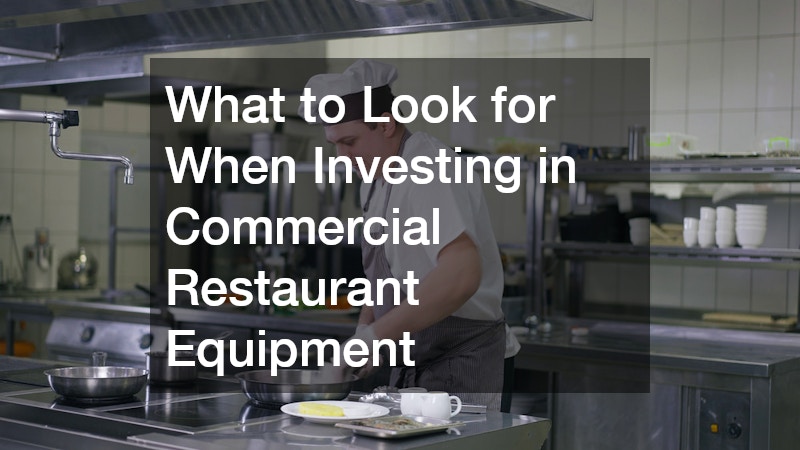In the bustling world of the restaurant industry, selecting the right commercial restaurant equipment can make or break your business. The right equipment not only enhances operational efficiency but also plays a significant role in cost management and customer satisfaction. From streamlining kitchen processes to ensuring food is served promptly and correctly, investing wisely in commercial equipment is paramount to a restaurant’s success.
Assessing Your Menu Requirements
Understanding your menu is the first step in determining the appropriate equipment for your restaurant. Evaluate the specific menu items you plan to offer and consider which appliances are indispensable for preparing those dishes. For instance, if your menu emphasizes grilled items, investing in high-quality grills and ventilation systems becomes essential for delivering consistent quality.
Each piece of equipment should complement your menu offerings to maximize kitchen efficiency. Beyond identifying necessary appliances, it’s important to think about how each piece will impact workflow. Considerations such as preparation time, cooking methods, and serving styles will guide your equipment selection.
Understanding Kitchen Layout Constraints
Space and layout are crucial factors to account for when choosing commercial kitchen equipment. A well-designed kitchen utilizes every inch efficiently, ensuring smooth movement for staff and preventing bottlenecks. By understanding your kitchen’s spatial limitations, you can select equipment that fits without disrupting workflow.
Consider how each appliance will integrate into the existing kitchen layout. Will a new piece of equipment hinder accessibility or create potential safety hazards? Opt for flexible solutions that serve your culinary needs while maintaining a comfortable, hazard-free environment for your staff.
Prioritizing Energy Efficiency
Incorporating energy-efficient equipment into your commercial kitchen can significantly reduce operational costs over time. Advanced technologies in newer appliances often provide better energy ratings, which translates to lower utility bills. This not only benefits your business’s bottom line but also supports environmental sustainability.
Energy-efficient equipment can qualify for rebates and incentives, offering potential upfront savings. It’s important to research available models and compare their energy consumption ratings. For example, ENERGY STAR rated appliances often perform up to 20% more efficiently than non-rated models.
Researching Brand Reputation
Brand reputation offers valuable insights into the quality and durability of commercial kitchen equipment. Top brands in the industry are renowned for their reliability and longevity, minimizing the likelihood of frequent replacements. This can significantly reduce unforeseen repair costs, promoting seamless kitchen operations.
Customer reviews and professional endorsements can guide you in selecting equipment that meets rigorous industry standards. By choosing reputable brands, you gain peace of mind knowing support, parts, and services are readily available. Empowering employees with dependable equipment boosts confidence and productivity in daily kitchen tasks.
Comparing Initial Costs vs. Long-term Value
When evaluating commercial equipment, it’s crucial to weigh initial costs against long-term value. While budget constraints may tempt you to choose less expensive options, consider the potential impact of ongoing maintenance and lower lifespan. Investing in quality equipment translates to consistent performance and reduced downtime.
Durable equipment sees fewer breakdowns and repairs, which reduces operational disruptions and service intervention costs. Calculating total ownership costs, including potential repair and energy consumption expenses, provides a comprehensive view of each equipment’s financial footprint. This helps you make informed decisions that benefit your financial future.
Checking for Warranty and Support Services
Warranty and support services are essential considerations when buying commercial restaurant equipment, safeguarding against unexpected mechanical issues. Comprehensive warranties demonstrate confidence in product reliability, offering access to parts and repair services. This ensures quick resolutions of equipment malfunctions, minimizing disruption to kitchen operations.
Post-purchase support, including scheduled maintenance and responsive customer service, safeguards the longevity of your investment. Engaging with providers offering robust support contracts can significantly ease stress related to equipment downtimes. Having a reliable point of contact ensures matters are resolved promptly, supporting business continuity.
Evaluating the Condition of Used Equipment
Purchasing used restaurant equipment can offer significant cost savings, but it’s vital to thoroughly examine the condition and functionality. Look for signs of wear and tear, and request maintenance records to assess the equipment’s history. Prioritize items with a known track record of durability and reliability to ensure value for money.
Testing the equipment before purchase is instrumental in verifying performance standards. Simple checks during an inspection can reveal underlying issues that aren’t immediately evident. Additionally, seek vendor guarantees or limited warranties that provide reassurance should problems arise post-purchase.
Making Informed Purchase Decisions
Navigating the decision to purchase new or used equipment requires a strategic assessment of needs, budget constraints, and future objectives. Balancing these factors empowers you to make decisions that optimize the restaurant’s operational framework and financial health. Strategic thinking in this area can mitigate risks and leverage opportunities for enhancement.
Investing in commercial restaurant equipment is a complex yet crucial aspect of establishing a successful culinary venture. By reflecting on menu requirements, accommodating kitchen layouts, and prioritizing energy efficiency, you position your restaurant for operational excellence. Beyond this, evaluating factors such as a brand’s reputation, long-term value, and warranty offerings ensures informed equipment selections.
Ultimately, thorough research and strategic applications prevent costly oversights and foster sustained success. Wise equipment choices manifest as customer satisfaction, workplace efficiency, and consistent profitability. These considerations guide your venture towards becoming a revered name in the restaurant industry, elevating your brand’s culinary prestige.


